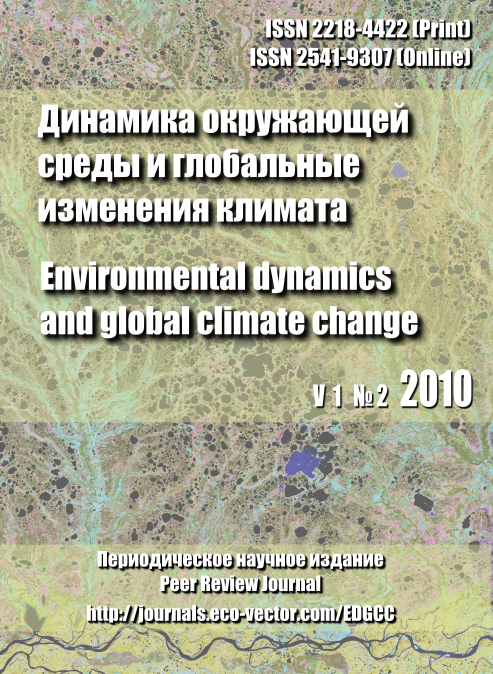Том 1, № 2 (2010)
- Год: 2010
- Выпуск опубликован: 15.06.2010
- Статей: 8
- URL: https://edgccjournal.org/EDGCC/issue/view/391
Статьи
Аннотированный список литературных источников по результатам измерений потоков СН4 и СО2 на болотах России
Аннотация
Аннотированный библиографический список отражает экспериментальные исследования обмена углерода между болотами и атмосферой, проводившиеся на территории России. Представлены публикации, содержащие результаты измерений удельного потока диоксида углерода и/или метана. Всего аннотированный список содержит около 200 публикаций.
 1-
1-


О связи суточной динамики концентрации метана над болотом с коэффициентом диффузии
Аннотация
Приведены данные об измерениях суточной динамики концентрации метана и коэффициента турбулентной диффузии в приземном слое атмосферы над олиготрофным болотным массивом. Подробно описана весьма простая в техническом отношении методика получения этих данных. Обсуждается вопрос влияния плотности потока метана и коэффициента диффузии в атмосфере на суточную динамику концентрации. Делается вывод о том, что суточная динамика концентрации метана в приземном слое атмосферы, главным образом, определяется процессами циркуляции в приземном слое. Построено регрессионное соотношение, связывающее концентрацию метана в приземном слое с коэффициентом турбулентной диффузии.
 2-
2-


«Cтандартная модель» Bс8 эмиссии CH4 из болот Западной Сибири
Аннотация
«Стандартная модель» представляет собой совокупность периодов эмиссии, картографической основы и плотностей распределения вероятностей величин потоков из типичных экосистем. На основе модели Вс8 региональная эмиссия СН4 из болот Западной Сибири оценивается величиной 2.9 ТгС-СН4/год.
 3-
3-


Запасы общей фитомассы и чистая первичная продукция болотных экосистем Сургутского Полесья
Аннотация
В работе дана количественная характеристика биологической продуктивности наиболее заболоченного региона Западной Сибири - Сургутского полесья. По запасам общей фитомассы болотные олиготрофные экосистемы достоверно различались в зависимости от занимаемого в микрорельефе положения: на микроповышениях (грядах и рямах) запас фитомассы составил 2500-3500 г/м2, в микропонижениях (мочажинах) - 1010-1250 г/м2. Тем не менее, чистая первичная продукция повышенных и пониженных элементов рельефа болотных экосистем Сургутского полесья оценивается в пределах 530-630 г/м2 в год и значимо не различается. Впервые изучен вклад древесного яруса болотных экосистем повышенного микрорельефа, который составил 30-40% от запаса всей живой фитомассы и 11-16% - от чистой первичной продукции.
 4-
4-


О 2-м международном полевом симпозиуме«Торфяники Западной Сибири и цикл углерода: прошлое и настоящее»
 5-
5-


Биологическая продуктивность олиготрофных и эвтрофных болот южной тайги Западной Сибири
Аннотация
Приводятся данные многолетних (1999-2006 гг.) измерений запасов биомассы, динамики прироста фитомассы и мортмассы, чистой первичной продукции (NPP) болотных биогеоценозов олиготрофного и эвтрофного типа, расположенных на территории южно-таежной подзоны Западной Сибири (Томская область). Выявлено, что запасы фитомассы и NPP эвтрофного болота почти в два раза выше по сравнению с олиготрофным. Динамика запасов фитомассы и мортмассы определяется видовым составом растительного покрова, трофностью местообитания и гидротермическими условиями.
 6-
6-


Эмиссия CO2 олиготрофными болотными почвами Западной Сибири
Аннотация
В работе представлены результаты исследования суточной и сезонной динамики эмиссии СО2 с поверхности олиготрофного болота в южно-таежной подзоне Западной Сибири в 2005-2007 гг. В течение летнего периода происходит увеличение интенсивности эмиссии СО2 от весны к середине лета и последующее снижение к осени. Среднее значение эмиссии СО2 составило 118 мгСО2 ⋅м-2⋅ч-1. Анализ суточной динамики эмиссии СО2 показал, что максимальный поток СО2 наблюдается в 16 часов, а минимальный - в 7 часов утра. Средняя амплитуда суточных колебаний эмиссии СО2 составляет 74 мгСО2 ⋅м-2⋅ч-1. Выявленные зависимости между температурой воздуха и потоком СО2 позволили рассчитать эмиссию углекислого газа в периоды между измерениями. Было выявлено, что для оценки эмиссии СО2 камерным методом в летнее время, оптимальным является период с 10 часов утра до 13 часов.
 7-
7-


История природной среды и развития болот в голоцене на восточном склоне Полярного и Приполярного Урала, Россия
Аннотация
Исследовались отложения мерзлых торфяников, вскрытых естественными обнажениями в берегах озер, ручьев и рек в зоне лесотундры восточного склона Полярного и северной тайги - Приполярного Урала методами палинологического, ботанического и радиоуглеродного анализов. В результате установлены основные этапы динамики растительности, экологических условий и процесса торфообразования в голоцене от предбореального до субатлантического периодов. В предбореальном периоде (более 9 тысяч лет назад) преобладала травяно-кустарниковая растительность: карликовые березки, ивы, злаки, осоки, полыни, маревые, разнотравье, споровые растения (мхи, хвощи) в сочетании с редколесьями из березы и лиственницы, а на Приполярном Урале - с примесью ели. Климатические условия были холодными и относительно сухими. С потеплением в бореальном периоде (около 9 тысяч лет назад) началась деградация многолетней мерзлоты, образование застойного переувлажнения пониженных участков, последующее зарастание их водными и водно-болотными растениями (рогоз, частуха, вахта, осоки и др.) и начало процесса торфообразования. На суходолах сформировались редкостойные леса паркового типа: лиственнично-березовые на Полярном Урале и лиственнично-еловые - на Приполярном. Атлантический период (8-5 тысяч лет назад) отличался наиболее теплыми климатическими условиями, оптимальными для произрастания мезофильной флоры и интенсивного торфонакопления. В это время ель распространилась на Полярный Урал, образовав там таежные еловые леса с примесью березы и лиственницы. На Приполярном Урале в это время произрастали хвойные леса также с преобладанием ели, с участием сосны, сибирского кедра и пихты средне- и южно-таежного облика. Похолодание в суббореальном периоде (около 3400 лет назад) привело к изреживанию древостоев, отступлению ели, прекращению торфообразования и последующему промерзанию торфяников. На Полярном Урале таежные леса сменились лесотундрой, на Приполярном Урале сформировались елово-сосново-кедровые леса северо-таежного типа. Установленная динамика растительности и болотообразовательного процесса на Приполярном Урале и Полярном Урале имеет идентичную направленность и отражает влияние общеклиматических изменений. Отличие заключается в более раннем начале торфонакопления и распространения ели на Приполярном Урале, где с атлантического периода произрастали также сосна и сибирский кедр. До Полярного Урала эти виды, по нашим данным, не доходили. Эти особенности несомненно обусловлены разницей в широтно-географическом расположении районов исследования и направлением распространения древесных растений в голоцене с юга на север вдоль восточного склона Уральских гор и вглубь хребта по долинам рек и вверх по горным склонам.
 8-
8-











